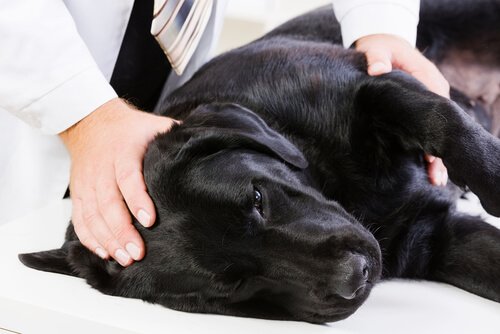Epilepsy In Dogs: Symptoms and Solutions

Epilepsy in dogs is one of the most distressing health problems for pet owners, mainly because they don’t know what to do when their dog is having a seizure. In this article, we’ll tell you everything you need to know about epilepsy in dogs.
Epilepsy in dogs: What is it?
Epilepsy is when your dog experiences repeated seizures or convulsions. Although these seizures can be caused by different things, they are considered to be epileptic when they happen on a regular basis.
When your dog has abnormal electrical activity in the brain, the neurons change and cause localized or general spasms. However, this happens regardless of what your dog is doing. These seizures can even happen while your dog is sleeping, lying down, or resting.
There are many different causes for epilepsy in dogs, from brain tumors to congenital defects, from hereditary conditions to general infections, or even swallowing garden pesticides.
There are also cases where epilepsy is caused by changes in blood composition, increased sodium or potassium electrolytes in the body. All of this causes greater excitation of neurons.

Epilepsy in dogs, step by step
Epileptic attacks can appear unexpectedly. They can last at most a minute and a half, although most owners believe they last a lot longer. Also, your dog will be really exhausted, as if he’s been exercising for hours.
The intensity of the seizure will depend on the area of the brain that’s affected. A dog can get general or localized convulsions. The main phases or stages of a fit seizure is as follows:
1. Initial phase
Also known as a prodrome, your dog will show changes in behavior, seem nervous, restless, and not normal. They might constantly try to get your attention, bark for no reason, fail to control their bladder or seem disorientated.
In time, you’ll eventually learn these signs and know within minutes that your dog is about to have an epileptic attack. This is important so that you can be prepared and move anything nearby that might injure your pet.
2. Convulsion phase
This moment, called an ictus, is when the fit starts. Your dog will move furiously and crawl to the ground. This is when the muscle contractions start, along with involuntary movements of the limbs, whimpering, howling, and excessive drooling. Their eyes may be open but “white”, and they may even lose control of their bladder or bowel movements.
This is the critical phase when things are at their worst. It’s really important to realize that your dog is unconscious during the whole time and could hit anything nearby. Try to use a blanket or rug for him to ‘fall onto’, and make sure that he’s in a quiet place. Above all, you need to stay calm.
3. Final phase
Once the seizure has stopped, your dog will remain still for a while or move slowly in a repeated fashion (as if he were dreaming). Next, they’ll feel confused, restless, disorientated, and will not respond to your calls.
They may want to get up off from the floor, but they will stumble and trip over thing easily. During this phase, it’s really important to let them relax, give them some water to drink, and a rug to sleep on while they recover. Be sure to keep the room calm and well-ventilated.

Are there any solutions?
Epilepsy in dogs is chronic and it lasts for life. There are no treatments to cure it. Since it’s mainly hereditary and affects the brain, there are very few medical or scientific advances that could help.
However, what you can do, is try to reduce your dog’s stress levels to prevent future seizures or make them as least likely as possible. How? Through alternative therapies such as homeopathy, reiki, or even acupuncture, but always from a professional.
The main thing to remember is that, when you’re faced with an epileptic episode, you need to stay calm and clear some space. That way you’ll prevent your dog from injuring himself during and afterward — when they’re disorientated.
Epilepsy in dogs is one of the most distressing health problems for pet owners, mainly because they don’t know what to do when their dog is having a seizure. In this article, we’ll tell you everything you need to know about epilepsy in dogs.
Epilepsy in dogs: What is it?
Epilepsy is when your dog experiences repeated seizures or convulsions. Although these seizures can be caused by different things, they are considered to be epileptic when they happen on a regular basis.
When your dog has abnormal electrical activity in the brain, the neurons change and cause localized or general spasms. However, this happens regardless of what your dog is doing. These seizures can even happen while your dog is sleeping, lying down, or resting.
There are many different causes for epilepsy in dogs, from brain tumors to congenital defects, from hereditary conditions to general infections, or even swallowing garden pesticides.
There are also cases where epilepsy is caused by changes in blood composition, increased sodium or potassium electrolytes in the body. All of this causes greater excitation of neurons.

Epilepsy in dogs, step by step
Epileptic attacks can appear unexpectedly. They can last at most a minute and a half, although most owners believe they last a lot longer. Also, your dog will be really exhausted, as if he’s been exercising for hours.
The intensity of the seizure will depend on the area of the brain that’s affected. A dog can get general or localized convulsions. The main phases or stages of a fit seizure is as follows:
1. Initial phase
Also known as a prodrome, your dog will show changes in behavior, seem nervous, restless, and not normal. They might constantly try to get your attention, bark for no reason, fail to control their bladder or seem disorientated.
In time, you’ll eventually learn these signs and know within minutes that your dog is about to have an epileptic attack. This is important so that you can be prepared and move anything nearby that might injure your pet.
2. Convulsion phase
This moment, called an ictus, is when the fit starts. Your dog will move furiously and crawl to the ground. This is when the muscle contractions start, along with involuntary movements of the limbs, whimpering, howling, and excessive drooling. Their eyes may be open but “white”, and they may even lose control of their bladder or bowel movements.
This is the critical phase when things are at their worst. It’s really important to realize that your dog is unconscious during the whole time and could hit anything nearby. Try to use a blanket or rug for him to ‘fall onto’, and make sure that he’s in a quiet place. Above all, you need to stay calm.
3. Final phase
Once the seizure has stopped, your dog will remain still for a while or move slowly in a repeated fashion (as if he were dreaming). Next, they’ll feel confused, restless, disorientated, and will not respond to your calls.
They may want to get up off from the floor, but they will stumble and trip over thing easily. During this phase, it’s really important to let them relax, give them some water to drink, and a rug to sleep on while they recover. Be sure to keep the room calm and well-ventilated.

Are there any solutions?
Epilepsy in dogs is chronic and it lasts for life. There are no treatments to cure it. Since it’s mainly hereditary and affects the brain, there are very few medical or scientific advances that could help.
However, what you can do, is try to reduce your dog’s stress levels to prevent future seizures or make them as least likely as possible. How? Through alternative therapies such as homeopathy, reiki, or even acupuncture, but always from a professional.
The main thing to remember is that, when you’re faced with an epileptic episode, you need to stay calm and clear some space. That way you’ll prevent your dog from injuring himself during and afterward — when they’re disorientated.
All cited sources were thoroughly reviewed by our team to ensure their quality, reliability, currency, and validity. The bibliography of this article was considered reliable and of academic or scientific accuracy.
Goiz-Márquez, G., Chacón, S. C., Ortiz, H. S., & López, H. S. (2008). Epilepsia en perros. Veterinaria Mexico.
This text is provided for informational purposes only and does not replace consultation with a professional. If in doubt, consult your specialist.








